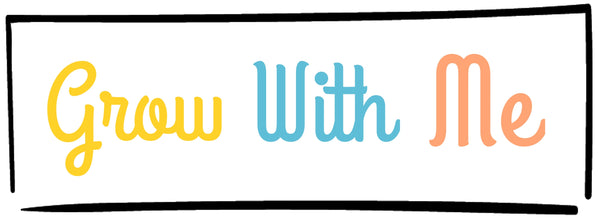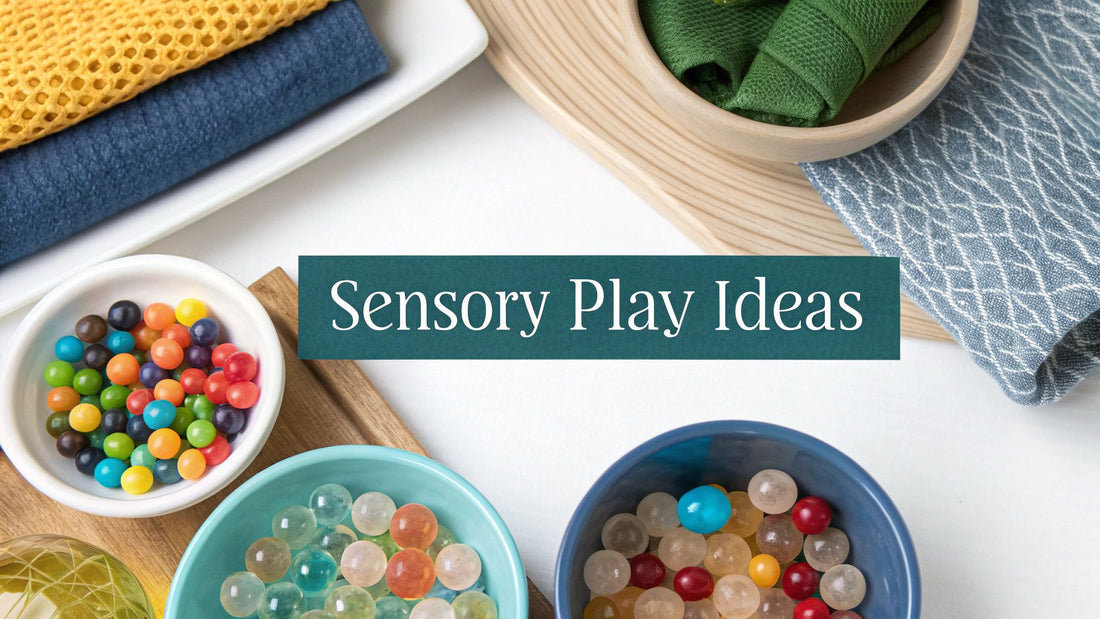
9 Essential Sensory Play Ideas for Toddlers (2025 Guide)
Share
Sensory play is far more than just messy fun; it's a critical component of early childhood development, laying the groundwork for how toddlers learn, think, and navigate their world. By engaging their senses-touch, smell, sight, sound, taste, balance (vestibular), and body awareness (proprioception)-toddlers build vital neural pathways in their brains.
These connections support everything from language development and cognitive growth to fine and gross motor skills. When a toddler squishes play dough or splashes in water, they are conducting scientific experiments, learning about cause and effect, and developing problem-solving abilities. This type of hands-on exploration provides concrete experiences that help abstract concepts become understandable. For example, pouring water from one container to another teaches fundamental principles of volume and physics in a way that is tangible and memorable for a young child.
Furthermore, sensory activities can be incredibly calming, helping little ones regulate their emotions and process overwhelming feelings in a safe, constructive manner. The repetitive, focused nature of many sensory tasks provides a soothing outlet for nervous energy and can improve a toddler's concentration.
This article explores a curated collection of fantastic sensory play ideas for toddlers, providing a comprehensive guide for parents and caregivers. We will delve into accessible and engaging activities designed to enrich your child's playtime and support their developmental journey. Each idea comes with practical steps and highlights specific benefits, demonstrating how to turn simple, everyday materials into powerful learning tools for your growing child. You'll find everything from classic play dough to nature-based exploration, all organised to help you create meaningful play experiences.
1. Play Dough and Clay Manipulation
Play dough and clay are classic yet powerful tools in the world of sensory play ideas for toddlers. This activity centres on providing malleable materials that children can squeeze, roll, pound, and shape, offering a rich tactile experience that engages the senses of touch, sight, and even smell. The resistance of the dough provides crucial proprioceptive feedback, helping toddlers develop an awareness of their body's position and strength.
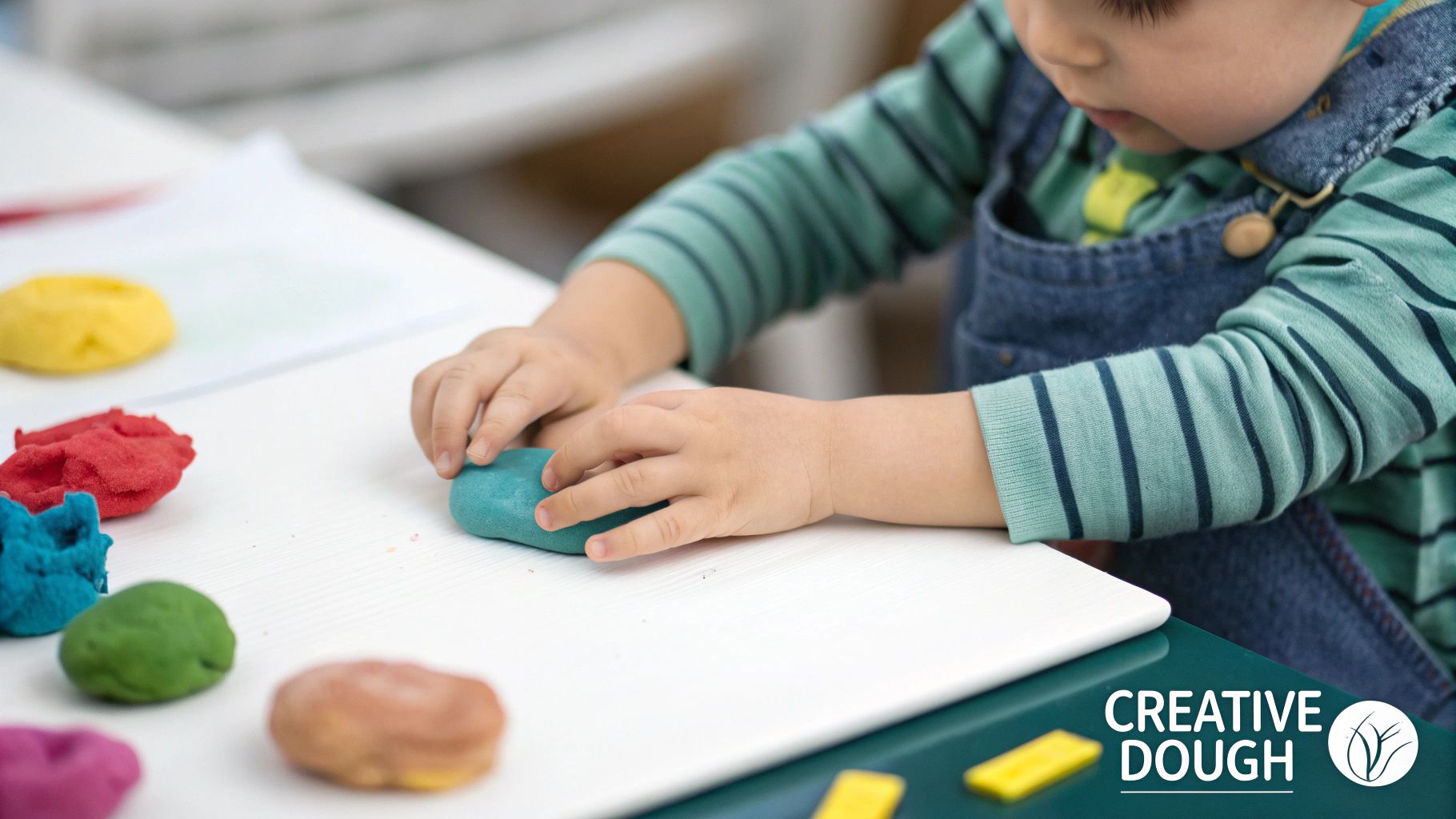
This form of sensory exploration is a cornerstone in various early childhood settings. Montessori classrooms, for instance, often incorporate natural clay for daily sensory work, while occupational therapy clinics use therapeutic putty to build hand strength and fine motor skills.
Why It's a Top Sensory Activity
Play dough manipulation is more than just fun; it's a developmental powerhouse. The simple act of squishing and rolling builds the small muscles in a toddler's hands and fingers, which is a vital pre-cursor to holding a pencil and writing. It also nurtures creativity, encourages focus, and can have a surprisingly calming effect on an overstimulated child.
How to Implement Play Dough Fun
Getting started is simple. You can use shop-bought dough or easily make your own taste-safe version at home using flour, salt, water, and cream of tartar.
- Enhance the Senses: Add a few drops of calming essential oils like lavender or chamomile. For a multi-sensory experience, use food colouring to create vibrant dough and add spices like cinnamon or cocoa powder for scent.
- Provide Tools: Introduce child-safe tools to encourage different types of manipulation. This could include small rolling pins, cookie cutters, plastic cutlery, or even natural items like shells, leaves, and twigs to make impressions.
- Create Themed Trays: Organise a "play dough tray" based on a theme. For a nature theme, you might include green dough, small animal figures, and pebbles. This transforms the activity into an imaginative play session.
Always supervise your toddler closely during play dough activities to ensure they do not try to eat it, and store your dough in an airtight container to keep it fresh for future sessions.
2. Water Play and Sensory Bins
Water play and sensory bins are a dynamic and engaging category of sensory play ideas for toddlers. This activity involves providing a contained area with water or other sensory materials, allowing children to pour, splash, scoop, and explore. It offers a rich sensory experience that stimulates the sense of touch through varying textures and temperatures, sight through colourful additions, and hearing through the sounds of splashing water.

This method is a staple in early years education. The Reggio Emilia approach, for instance, frequently uses water tables as centres for child-led discovery, while sensory integration therapy, pioneered by experts like Jean Ayres, incorporates water play to help children process tactile information. At home, a simple basin or bin can become a powerful tool for learning.
Why It's a Top Sensory Activity
Water play is exceptionally versatile and provides immediate sensory feedback. The simple act of pouring water from one cup to another teaches fundamental concepts of volume, gravity, and cause-and-effect. It helps toddlers develop hand-eye coordination, builds fine and gross motor skills, and can be either incredibly stimulating or wonderfully calming depending on how the activity is structured.
How to Implement Water Play Fun
Setting up a water-based sensory bin is straightforward and can be adapted to any space, indoors or out. Use a large, shallow plastic bin, a baby bath, or a designated water table.
- Contain the Mess: Lay down a large waterproof mat or old towels to catch spills, especially for indoor play. Setting up outside on a warm day is often the easiest option.
- Introduce Tools: Provide a variety of tools to encourage exploration. Measuring cups, funnels, sponges, ladles, and floating toys are excellent starting points. You can discover more about how these simple items serve as excellent developmental toys for toddlers.
- Vary the Experience: Add soap to create foam, use a few drops of food colouring to tint the water, or add ice cubes to explore temperature changes (always test water temperature for safety first). Natural items like smooth stones, leaves, and shells also make wonderful additions.
Always ensure constant and close supervision whenever a toddler is playing with water, regardless of the depth. This keeps the experience safe, fun, and full of sensory discovery.
3. Sand and Kinetic Sand Exploration
Sand play is a quintessential sensory activity, offering toddlers a unique tactile experience through its flowing, granular, and mouldable properties. This classic form of sensory play engages the sense of touch as children sift, pour, and shape the material. The subtle resistance and texture of traditional sand provide rich sensory input, while its modern counterpart, kinetic sand, offers a contained, less messy alternative that sticks to itself, making it ideal for indoor use.
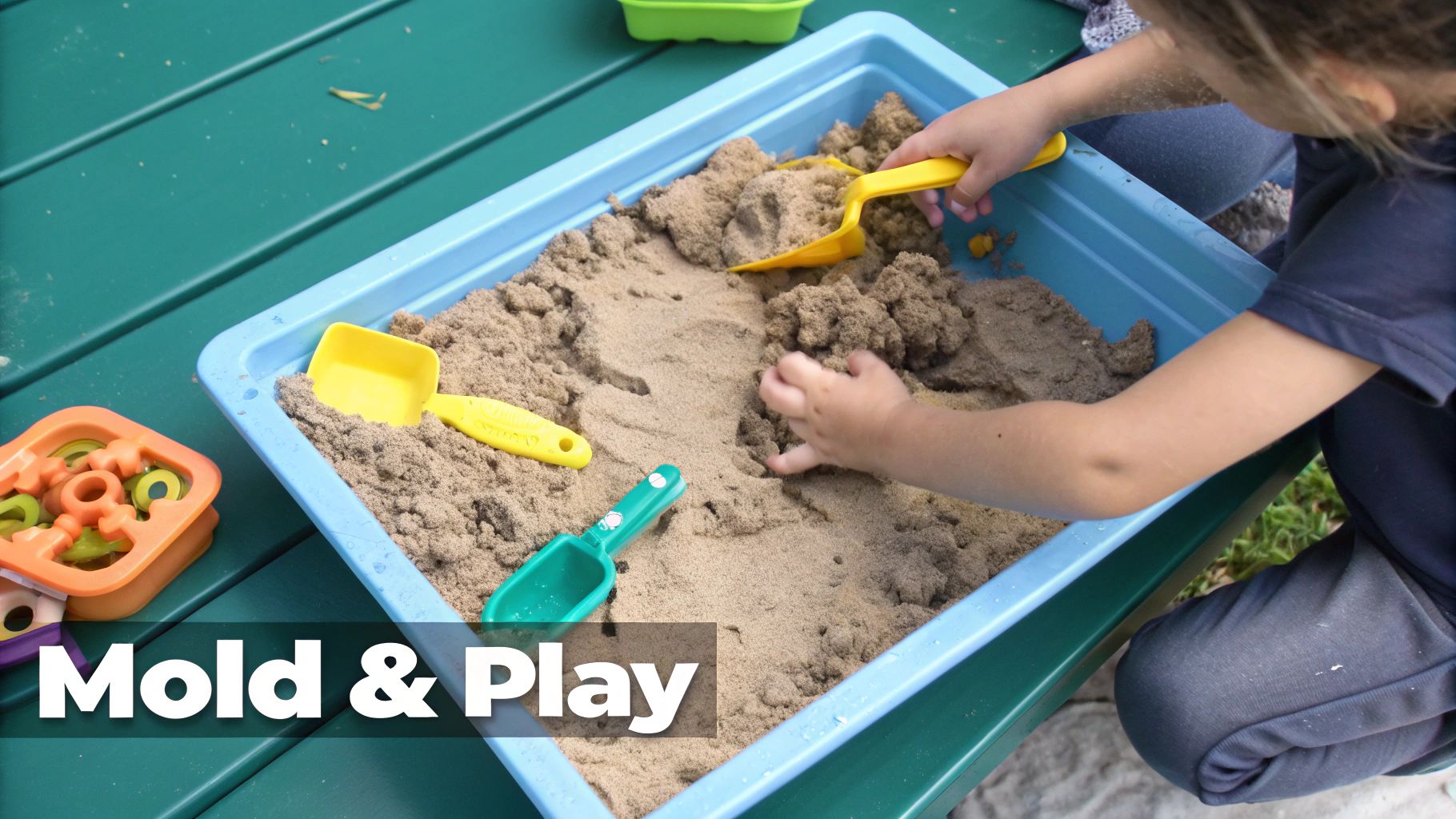
This type of hands-on exploration is a staple in many child-focused environments. Waldorf schools have long championed sandbox play as a core part of their curriculum to connect children with natural materials. Similarly, paediatric therapy centres often use sand trays for sensory regulation and to help children express themselves non-verbally.
Why It's a Top Sensory Activity
Sand exploration is a fantastic sensory play idea for toddlers because it powerfully supports fine motor development. The acts of scooping, pouring, and digging strengthen hand-eye coordination and the small muscles in the hands. The unique texture can also be incredibly calming and grounding for many children, helping them to focus and self-regulate when feeling overwhelmed or anxious.
How to Implement Sand Play
Setting up a sand station can be done indoors or outdoors. For indoor play, use a dedicated bin or sensory table to contain the mess. You can start with either natural play sand or kinetic sand.
- Provide Tools: Offer a variety of tools to encourage exploration and manipulation. Simple items like spoons, cups, small buckets, funnels, and moulds can transform the activity and inspire creative construction.
- Add Thematic Elements: Introduce small world figures like sea animals, construction vehicles, or dinosaurs to spark imaginative play. Burying "treasures" like smooth stones or shells for your toddler to find adds an exciting element of discovery.
- Enhance the Senses: For a multi-sensory experience, consider using coloured kinetic sand to add visual appeal. You can also hide scented items within the sand for an olfactory surprise.
Always supervise young children during sand play to ensure they do not put the sand in their mouths. A small dustpan and brush or a handheld vacuum nearby can make clean-up much easier for indoor setups.
4. Finger Painting and Sensory Art
Finger painting and other forms of sensory art are fantastic sensory play ideas for toddlers, focusing on the creative process rather than a polished final product. This activity invites children to explore textures, colours, and the pure joy of messy creation. It directly engages the tactile system as toddlers feel the paint on their skin, the visual system as they watch colours mix and spread, and can even involve the olfactory system with scented paints.
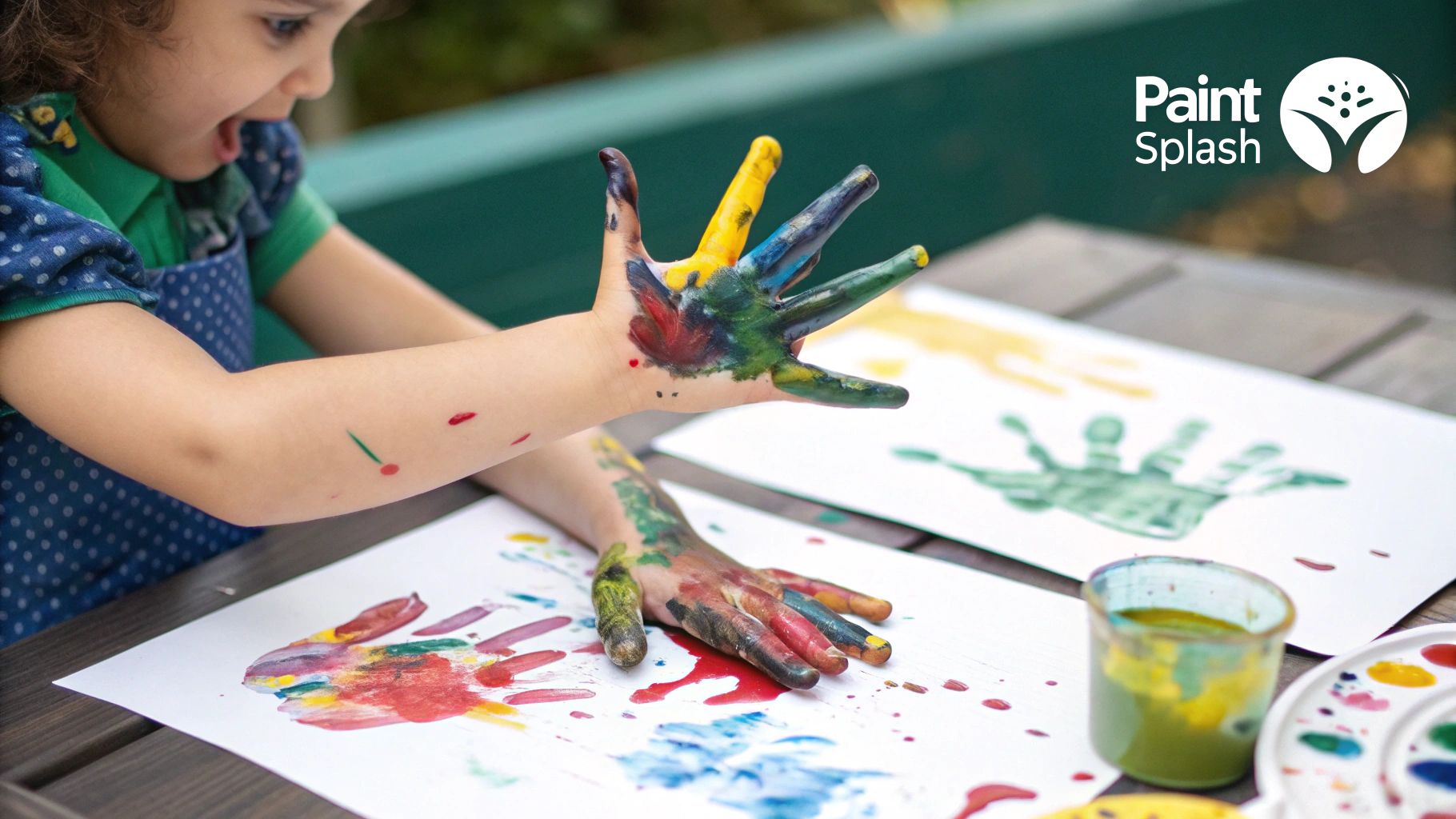
This process-oriented approach is a key component of the Reggio Emilia educational philosophy, which values a child's artistic expression as a primary language for learning and discovery. Similarly, art therapy programmes for young children use these methods to help them express emotions that they may not yet have the words for, highlighting its deep developmental value.
Why It's a Top Sensory Activity
Finger painting is more than just making a colourful mess; it's a powerful tool for sensory integration and emotional expression. The direct contact with paint provides rich tactile feedback, helping to desensitise children who may be wary of certain textures. It also supports fine motor skill development, hand-eye coordination, and colour recognition, all while offering a safe outlet for a toddler's boundless creativity and curiosity.
How to Implement Sensory Art Fun
Setting up a sensory art session is straightforward and can be adapted to your comfort level with mess. Always use washable, non-toxic paints specifically designed for young children.
- Prepare the Space: Lay down an old sheet, newspaper, or a plastic mat. Conducting this activity outdoors or in a tiled area like a bathroom makes clean-up much easier. Don't forget a smock or old clothes for your toddler.
- Offer Different Tools: While fingers are the main event, introduce variety with sponges, large brushes, leaves, or even toy cars to paint with. This shows toddlers that art can be made with anything and offers different tactile experiences.
- Try Edible Options: For toddlers who are still exploring everything with their mouths, create taste-safe finger paints using plain yoghurt mixed with a few drops of food colouring. This ensures the experience is safe and stress-free.
Always supervise closely to ensure a safe and positive experience. The goal is to let your toddler explore the textures and colours freely, celebrating the sensory journey of creation.
5. Rice and Grain Sensory Bins
Rice and grain sensory bins are a foundational activity among sensory play ideas for toddlers, offering a wonderfully simple yet effective tactile experience. This concept involves filling a shallow container with dry materials like rice, pasta, beans, or lentils, which toddlers can scoop, pour, and sift through. The feel of the tiny grains running through their fingers provides significant tactile input, while the sounds of pouring and rustling engage their auditory sense.
This method is a staple in many early years settings, from Montessori classrooms using specific grain-pouring exercises to develop concentration, to home preschools creating elaborate themed bins. Occupational therapists also utilise grain bins for tactile desensitisation and to enhance hand-eye coordination in a controlled, engaging way.
Why It's a Top Sensory Activity
The beauty of a rice or grain bin lies in its versatility and developmental benefits. The act of scooping and pouring is a fantastic workout for fine motor skills, building the dexterity needed for self-feeding with a spoon and eventually writing. It also introduces early mathematical concepts like volume, capacity ("full" vs. "empty"), and measurement in a hands-on, playful context.
How to Implement Rice and Grain Fun
Creating a sensory bin is straightforward and can be adapted with whatever you have available. A large, shallow plastic storage container works perfectly as the bin itself.
- Enhance the Senses: Add visual excitement by colouring plain rice. Simply mix a few drops of food colouring and a teaspoon of vinegar with dry rice in a sealed bag, shake well, and lay it out on a tray to dry completely.
- Provide Tools: Include a variety of tools to encourage different types of exploration. Measuring cups, spoons, funnels, small pots, and even toy diggers can transform the bin into a rich play environment.
- Create Themed Trays: Design a themed experience to spark imagination. For a farm theme, add small animal figures and tractors. For a "treasure hunt," hide colourful pom-poms or large, smooth stones within the grains for your toddler to find.
Always ensure close supervision during this activity to prevent your toddler from putting small items in their mouth. Placing the bin on a large towel or old sheet makes clean-up much easier.
6. Music and Movement Sensory Activities
Music and movement activities are a joyful and dynamic form of sensory play for toddlers, expertly blending auditory, vestibular (balance), and proprioceptive (body awareness) input. This approach uses rhythm, melodies, and physical expression to help children process sensory information, develop crucial motor skills, and learn to regulate their bodies and emotions. The combination of sound and motion creates a rich, multi-sensory experience that is both stimulating and organising for a young child's nervous system.
This powerful connection between sound and movement is recognised in early education worldwide. Acclaimed programmes like Music Together and Kindermusik have built curricula around this concept, while Waldorf schools incorporate eurythmy (artistic movement) to harmonise a child's physical and emotional development.
Why It's a Top Sensory Activity
Music and movement go beyond simple fun; they are fundamental to brain development. Listening to different rhythms helps toddlers develop auditory processing skills, while dancing, jumping, and swaying build gross motor skills, coordination, and spatial awareness. This type of active sensory play for toddlers is also a fantastic outlet for emotional expression and can significantly improve mood and focus.
How to Implement Music and Movement Fun
Integrating music and movement into your daily routine is easy and requires minimal setup. The goal is to create a playful and responsive environment where your toddler feels free to explore sound and motion.
- Vary the Tempo: Alternate between fast, energetic songs that encourage big movements like jumping and clapping, and slow, calming melodies that promote gentle swaying or stretching. This helps toddlers learn about self-regulation.
- Introduce Simple Instruments: Provide age-appropriate instruments like shakers, tambourines, or small drums. This adds a tactile element and teaches cause and effect as they create their own sounds.
- Use Visual Props: Enhance the experience with colourful scarves, ribbons, or even bubbles. These props provide visual and tactile feedback as they move through the air, encouraging toddlers to reach, stretch, and twirl.
- Play Movement Games: Organise simple games like "Freeze Dance" or "Simon Says" with actions like "stomp like a dinosaur" or "float like a feather." This makes listening an active, engaging process.
Always be mindful of your child's sensory needs; for toddlers sensitive to loud noises, start with softer music or provide the option of noise-reducing headphones to ensure the experience remains positive and enjoyable.
7. Texture Exploration Boards and Bags
Texture exploration boards and bags offer a clean, contained, and highly focused way to introduce toddlers to a world of different tactile sensations. This activity involves curating a collection of diverse materials with varying textures, either mounted securely onto a board or sealed within a sensory bag, allowing children to touch and feel without any mess. It provides a rich tactile experience that is crucial for sensory processing and cognitive development.
This method is a staple in many therapeutic and educational settings. Occupational therapists frequently use texture boards to help children with tactile sensitivities gradually become more comfortable with new sensations, while special needs classrooms use them as a tool for descriptive language development and focused sensory input.
Why It's a Top Sensory Activity
Texture boards and bags are brilliant sensory play ideas for toddlers who may be hesitant about messy play. They isolate the sense of touch, allowing a child to explore materials like sandpaper, silk, bubble wrap, or faux fur in a non-threatening way. This exploration helps build neural pathways in the brain, enhances fine motor skills as they pinch and stroke the materials, and expands their vocabulary as you name the textures: "rough," "smooth," "bumpy," "soft."
How to Implement Texture Exploration
Creating a texture board at home is a simple and rewarding DIY project. You just need a sturdy piece of cardboard or wood and a strong, non-toxic adhesive to attach your textured items.
- Vary the Textures: Aim for a wide range of sensations. Include things that are soft (cotton balls, velvet), rough (sandpaper, Velcro), bumpy (bubble wrap, corrugated card), smooth (satin, foil), and crinkly (cellophane).
- Secure Everything Firmly: The most important safety consideration is to ensure all materials are securely glued down to prevent any small pieces from becoming a choking hazard. Supervise your toddler at all times during this activity.
- Create Themed Boards: Organise boards around a theme to make the experience more engaging. A "nature board" could feature bark, leaves, smooth stones, and moss, while a "household board" might have a sponge, a piece of carpet, and different fabrics. These are just a few examples of how you can create your own sensory toys for babies and toddlers.
8. Bubble Play and Sensory Science
Bubble play is a delightful and multi-sensory experience that goes far beyond simple backyard fun. This activity involves creating and interacting with bubbles, offering a captivating blend of visual, tactile, and sometimes even olfactory and gustatory sensations. As toddlers track the shimmering orbs floating through the air, they engage their visual systems, and the gentle pop on their skin provides light tactile input, making it one of the most engaging sensory play ideas for toddlers.
This simple activity is widely used in various therapeutic and educational environments. Sensory integration therapy clinics often use bubble play to improve visual tracking and motor skills, while children's hospitals may use bubbles as a calming distraction technique. It’s a low-cost, high-impact tool for sensory exploration.
Why It's a Top Sensory Activity
Bubble play is an exceptional sensory activity because it naturally encourages visual tracking, a key skill for later reading. It also introduces the concept of cause and effect as toddlers learn that blowing through a wand creates bubbles. The experience can be incredibly calming for an overwhelmed child or serve as an exciting, active outdoor game.
How to Implement Bubble Play Fun
You can easily get started with a standard bottle of bubble solution and a wand, but expanding on the basic setup unlocks even more sensory benefits.
- Vary the Bubbles: Introduce different tools to create a variety of bubble sizes, from tiny ones using a multi-holed wand to giant ones using a string wand. For children who tend to put things in their mouths, consider taste-safe edible bubbles.
- Create Bubble Foam: A fantastic tactile alternative is bubble foam. Simply mix 2 parts water with 1 part tear-free bubble bath or soap and a few drops of food colouring. Whisk it with a hand mixer until stiff peaks form, and place it in a sensory bin for hands-on play.
- Automate for Immersion: Use a bubble machine to create a constant stream of bubbles. This provides continuous sensory input and frees you up to interact with your child, encouraging them to clap, stomp, or chase the bubbles.
Always supervise young children during bubble play to ensure they don't ingest a large amount of soap solution, and be mindful that surfaces can become slippery.
9. Nature-Based Sensory Collection and Exploration
Nature-based sensory play centres on bringing the rich, authentic textures of the outdoors into your toddler’s hands. This idea involves gathering natural materials like leaves, pinecones, flowers, smooth stones, and twigs, offering an unparalleled sensory experience that connects children directly with the natural world. This hands-on exploration engages touch, sight, smell, and even sound, as toddlers crunch leaves or snap twigs.
This philosophy is a cornerstone of the Forest School movement and is heavily influenced by nature-based education advocates like Richard Louv. Such approaches champion the use of real, natural materials to ground a child's learning in the tangible world around them, fostering curiosity and respect for the environment from a young age.
Why It's a Top Sensory Activity
Exploring natural items offers a sensory richness that manufactured toys often cannot replicate. The varied textures, unique smells, and imperfect shapes of leaves, bark, and stones provide complex sensory input that stimulates brain development. It encourages toddlers to observe details, ask questions, and develop a genuine appreciation for nature, all while building fine motor skills through gathering and sorting.
How to Implement Nature Exploration
Integrating nature-based sensory play ideas for toddlers into your routine is both simple and rewarding. It can begin with a walk around your garden or a local park.
- Go on a Nature Walk: Equip your toddler with a small basket or bag and go on a "treasure hunt". Encourage them to find interesting items, discussing their textures (bumpy pinecone, smooth stone) and smells (earthy soil, fragrant flowers).
- Create Seasonal Sensory Bins: Organise collected items into a sensory bin. An autumn bin might contain colourful leaves, conkers, and twigs, while a spring bin could feature petals, fresh grass, and small blossoms. For even more nature-inspired play, you can explore options like a toddler subscription box in the UK that often includes nature-themed activities.
- Introduce Tools for Discovery: Add simple tools like a magnifying glass to help your toddler inspect their treasures up close. Tongs and small shovels can also be used to practise motor skills while moving items around a sensory tray.
Always teach your toddler which natural items are safe to touch and which to avoid (like certain berries or fungi). Supervise play and ensure everyone washes their hands thoroughly after exploring.
Sensory Play Ideas Comparison Table
| Sensory Activity | Implementation Complexity 🔄 | Resource Requirements ⚡ | Expected Outcomes 📊 | Ideal Use Cases 💡 | Key Advantages ⭐ |
|---|---|---|---|---|---|
| Play Dough and Clay Manipulation | Medium | Low - homemade or store-bought | Fine motor skills, proprioceptive input | OT clinics, Montessori classrooms, preschools | Calming, creative, reusable, inexpensive |
| Water Play and Sensory Bins | Medium-High | Moderate - water, bins, toys | Cognitive development, bilateral coordination | Reggio Emilia, therapy clinics, home setups | Engaging, soothing, versatile |
| Sand and Kinetic Sand Exploration | Medium | Moderate - sand or kinetic sand | Fine motor skills, creativity, calming | Waldorf schools, therapy centers, museums | Long engagement, bilateral coordination |
| Finger Painting and Sensory Art | High | Moderate - paints, tools | Creative expression, fine motor skills | Art therapy, Reggio Emilia, family programs | Expressive, emotional regulation |
| Rice and Grain Sensory Bins | Low-Medium | Low - pantry staples | Proprioceptive and tactile input | Montessori, home preschools, OT clinics | Less messy, inexpensive, reusable |
| Music and Movement Sensory Activities | Low-Medium | Low - instruments, music source | Gross motor, sensory regulation | Music classes, hospitals, Waldorf schools | Motivating, emotional support, family-friendly |
| Texture Exploration Boards and Bags | Low | Low - assorted tactile materials | Tactile tolerance, sensory desensitization | OT clinics, special education, home use | Portable, clean, customizable |
| Bubble Play and Sensory Science | Low | Low - bubble solutions, wands | Visual tracking, cause-effect learning | Therapy clinics, preschools, hospitals | Highly appealing, inexpensive |
| Nature-Based Sensory Collection | Medium | Low - natural outdoor materials | Environmental awareness, tactile input | Forest schools, nature preschools, gardens | Authentic, free, seasonal variation |
Bringing It All Together: A Sensory-Rich Playtime Routine
We have journeyed through a vibrant world of squishing, splashing, building, and creating, exploring nine distinct avenues of sensory play ideas for toddlers. From the tactile feedback of moulding play dough and the cool splash of water play to the intricate textures of a nature-based collection, each activity offers a unique pathway for your child's development. The common thread weaving them all together is the profound impact they have on building neural connections, refining motor skills, and fostering a deep sense of curiosity about the world.
The core takeaway is that sensory play is far more than just a method to keep a toddler occupied. It is a fundamental component of early childhood education. When your little one is happily finger painting, they are not just making a mess; they are conducting experiments in cause and effect, learning about colour mixing, and developing the fine motor control necessary for future writing. Similarly, a simple rice bin becomes a laboratory for understanding volume, texture, and object permanence.
Making Sensory Play a Seamless Part of Your Week
Incorporating these sensory play ideas into your toddler's routine doesn't need to be an overwhelming overhaul of your schedule. The key is to start small and build momentum, creating a sustainable habit of exploration and discovery.
- Start with One: Choose just one new activity from this list to try this week. Perhaps it's a simple texture board on Monday or some supervised water play on a sunny afternoon. Observe what captures your child’s interest.
- Create a 'Sensory Station': Designate a small, easy-to-clean area for these activities. This could be a tuff tray in the garden, a mat on the kitchen floor, or a specific low table. Having a dedicated space makes setup and cleanup feel much more manageable.
- Rotate Activities: A toddler's interests can change quickly. To keep things fresh and engaging, try rotating different sensory bins or activities every week or two. Reintroducing a familiar activity after a break can also spark renewed interest.
The ultimate goal is to offer your child a varied and balanced 'sensory diet'. Just as a balanced food diet provides essential nutrients for physical growth, a diverse range of sensory experiences provides the crucial input their brain needs to grow, organise information, and understand their environment.
Embracing the Process Over Perfection
It is vital to remember that the true value of sensory play lies in the process, not the final product. The beautifully organised, colour-coded sensory bins we often see online are inspirational, but the reality of toddler play is gloriously messy and wonderfully chaotic.
The most significant learning happens when children are given the freedom to explore materials in their own way. A perfectly sorted bin of rainbow rice will likely become a mixed-up pile within minutes, and that is precisely the point. It is in the mixing, pouring, and scooping that the real developmental magic unfolds.
Resist the urge to direct their play too much. Instead, sit alongside them, model curiosity, and provide a safe space for their experimentation. This approach not only builds their confidence and problem-solving skills but also strengthens your connection as you share in their moments of discovery. By embracing the mess and focusing on the joy of the experience, you are communicating to your child that their exploration is valued and their curiosity is a wonderful thing. This foundational mindset will empower your toddler to approach all future learning with confidence and enthusiasm, knowing that the journey of discovery is the real reward.
Ready to provide consistent, high-quality sensory experiences without the stress of sourcing and planning? The subscription boxes from Grow With Me are expertly curated to support your child’s developmental stage with beautiful, natural toys and activities. Take the guesswork out of sensory play and watch your child flourish with Grow With Me.
